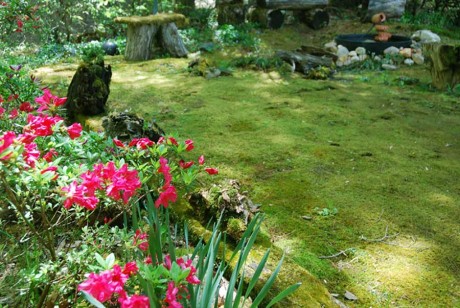Go green with moss
By Annie Martin, Mountain Moss Enterprises
Eco-friendly mosses provide viable horticultural solutions and year-round green appeal for shade gardens, green roofs, stone patios and even as moss lawns. Since mosses require no fertilizers, herbicides or pesticides, they have no negative impact on groundwater. Environmental benefits complement the aesthetic appeal of a serene moss garden. Mosses soothe the soul and bring a smile to your spirit.
From the mountains to the sea, you can establish a landscape of these ancient plants with a myriad of textures, shapes and shades of green. Over 450 million years old, mosses can enhance the beauty of any garden. You don't need to have a "green thumb" to grow green mosses. Following the horticultural guideline of "right place, right plant," you can create a verdant green patchwork that will provide delight throughout all seasons.
With over 600 types of bryophytes indigenous to North Carolina, there is a right moss for every place. Only a few bryophytes have common names like "Fern Moss," "Log Moss" or "Pincushion Moss". Therefore, moss references use scientific names like Thuidium delicatulum, Hypnum curvifolium, or Leucobryum glaucum. The elegance of these names hint of the miniature features of various mosses. Indeed, Thuidium delicatulum looks like tiny, delicate fern fronds.
Consider creating moss focal areas, using moss instead of mulch, "greening" your stone patios or walls, or converting grass into a moss lawn. First, assess your micro-environments. Using appropriate mosses for various sun exposures and different substrates is key. It is a myth that all mosses require shade. Many Carolina bryophytes tolerate partial shade and sun, and even direct sun.
Look around your place
As a novice, you might start with a shade moss garden which presents fewer challenges and certainly reduces your weeding chores. Look around the perimeter of your property for mosses that could be transplanted to your preferred location. If purchasing mosses, confirm plants have been legitimately harvested or propagated by a moss grower. Do not remove plants from public forests and parks. Native plant rescue groups exist around the Carolinas providing acquisition opportunities.
Don't be fooled by moss fakers which include: Spanish Moss (Bromeliad family), Reindeer Moss (lichen); Club Moss (lichopod); and Irish Moss or Scotch Moss (Vascular plants with roots and flowers).
Unique botanical characteristics distinguish bryophytes from other plants. True mosses are nonvascular. Rhizoids rather than roots help connect them to soil or stones. Mosses have no flowers, and consequently no seeds either. Yet, their sporophytes do display brilliant reds, golds, and bronzes to complement their normal year-round green appearance.
Another unusual aspect of mosses is that their leaves have no cuticle and are only one cell layer thick. This characteristic enables mosses to derive their entire sustenance from rainfall and dust particles directly through the leaves.
Mosses and water
Adequate humidity, rainfall, and/or supplemental watering are key factors in maintaining a sustainable moss garden. Stress-tolerant mosses don't follow typical seasons like other vascular plants, even growing in freezing winter temperatures and seemingly unfavorable soils.
The appearance of bryophytes drastically changes based on moisture content. During low rainfall periods, provide additional drinks for thirsty mosses. Drenching soaks are rarely needed, just thorough spraying or misting regularly in late afternoon, especially on hot, dry days.
Periodically remove dead leaves with a blower, not a rake.
Before planting, clear intended space of any weeds or debris. Remove all mulch. A general rule for acid-loving mosses is pH 5.5. (Some bryophytes prefer limestone substrates and have different pH requirements.) Place mosses on hard-packed soil, inter-leafing edges of the pleurocarpus mosses (carpets) and huddling together acrocarpus types (mounds) for moisture retention.
Water thoroughly and walk on mosses every day for 2–3 weeks to help establish your mosses.
If you've chosen the right moss for the right place and provide consistent watering with occasional leaf removal and weeding, you can be successful in your efforts.
To learn more about mosses and native plant rescues:
About the Author
Annie Martin, known as "Mossin' Annie", is the owner of Mountain Moss Enterprises in Pisgah Forest and a Transylvania County Master Gardener Volunteer. She can be reached at mossinannie@gmail.com-
Share this story:




Comments (11)
Mary Vaughan |
January 12, 2018 |
reply
Mossin' Annie Martin |
January 14, 2018 |
reply
Thanks!
Mary Vaughan
Mary Vaughan |
January 15, 2018 |
reply
Mossin' Annie Martin |
January 15, 2018 |
reply
Santiago |
February 21, 2018 |
reply
Mossin' Annie |
February 26, 2018 |
reply
Santiago |
February 28, 2018 |
reply
I am looking for a substitute for grass. I have an area that is high traffic but also it is under 2 very big trees and provides enough shade but in the afternoons it’s sunny. I have difficulty growing grass therefore I’m trying to find something to substitute and can spread easily. If you have any recommendations I would greatly appreciated it. Thank you.
Liz |
May 13, 2020 |
reply
Missy Vorus |
May 02, 2022 |
reply
It's good to hear that you are embracing mosses at your home. Weeds and stray grass can be quite aggravating in a moss landscape if allowed to get out of hand. It's best to address weed issues early in the season. Many moss gardeners prefer to carefully weed by hand. While tedious and time-consuming, it can be a Zen experience. However, if you are dealing with a massive investation of weeds, there are alternatives.
One way is to weedeat weeds down to the ground before going to seed. Mowing any grass and weeds to the lowest height possible can be an intermediary method to discourage growth. If you are willing to use chemicals, then you can apply WEED and GRASS KILLER to the moss areas. Note: Spectracide Weed and Grass Killer is available at most garden centers. It can be used straight off the shelf without dilution. Follow directions and apply when temperatures are between 60-80 degrees F. The systemic killer should take effect within 15 minutes but plan to apply it at least 2 hours before any rain is predicted. Don't expect to see much sign of death for about 2 days. Small weeds will dissipate away. Larger, ugly dead weeds may still need to be removed by hand. IMPORTANT: Don't apply when it has been extremely dry and mosses are already stressed. Typically, mosses are unaffected while weeds die. Try this method in a small area first. Repeat applications may be necessary for certain weeds that have left seeds behind or that have tenacious tendencies. Other chemical killers can be used by professional landscapers and homeowners as well; sometimes, other brands need to be diluted.
As for the weed that you've described, it sounds like it's Oxalis stricta (Yellow Wood Sorrel). It a common perennial weed in Southern lawns. It has rambling roots that are difficult to remove from mosses by hand. Oxalis is considered a valuable pollinator plant providing a generous amount of pollen that bees and butterflies use as a food source.
Good luck in dealing with weeds in your moss garden.
-- Mossin' Annie
Author, The Magical World of Moss Gardening and Owner, Mountain Moss Enterprises www.mountainmoss.com
Mossin' Annie Martin |
May 10, 2022 |
reply
Bruce Sauls |
August 08, 2023 |
reply